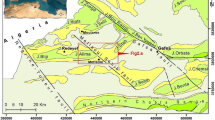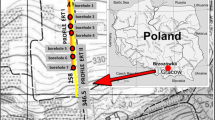Abstract
Kat County, which is located in a slope of hilly region and constructed in the side of a mountain along the North Anatolian Fault Zone, is frequently subject to landslides. The slides occur during periods of heavy rainfall, and these events cause destruction to property, roads, agricultural lands and buildings. In the last few decades, a lot of houses and buildings have been damaged and destroyed. Settlement areas have remained evacuated for a long time. The slope instabilities in the study area are a complex landslide extending from north to south containing a lot of landslides. Field investigations, interpretation of aerial photography, analyses of geological data and laboratory tests suggest that some factors have acted together on the slopes to cause the sliding. In the wet season, the slopes became saturated. As the saturation of the earth material on the slope causesa rise in water pressure, the shear strength (resisting forces) decreases and the weight (driving forces) increases; thus, the net effect was to lower the safety factor. Previous failures have affected the rock mass, leading to the presence of already sheared surfaces at residual strengths. The relation between the joint planes and the instability of the slope in the study area was discussed and it was found that the potential slope instabilities are mainly in the directions of NW–SE, NE–SW and N–S. The landslide susceptibility map obtained by using the geographical information system showed that a large area is susceptible and prone to landslides in the northern part of the study area.

















Similar content being viewed by others
References
Abderahman NB (1998) Landslides at km 56.4 along the Irbid–Amman highway, Northern Jordan. AAPG Div Environ Geosci 5(3):103–113
Bowles JE (1992) Engineering properties of soils and their measurement. McGraw-Hill Inc., New Jersey, pp 241
Bozkurt E, Koçyigit A (1995) Almust fault zone: its age, total offset and relation to the North Anatolian fault zone. Turk J Earth Sci 4:93–104
Bozkurt E, Koçyigit A (1996) The Kazova basin: an active negative flower structure on the Almus Fault Zone, a splay fault system of the North Anatolian Fault Zone, Turkey. Tectonophysics 265:239–254
Fernández T, Irigaray C, Hamdouni RE, Chacón J (2003) Methodology for landslide susceptibility mapping by means of a GIS. Application to the Contraviesa Area (Granada, Spain). Nat Hazards 30:297–308
Goodman RE (1989) Introduction to rock mechanics, 2nd edn. Wiley, New York
Hoek E, Bray J (1981) Rock slope engineering. Institution of mining and metalurgy, London
Hutchinson JN (1988) General report: morphological and geotechnical parameters of landslides in relation to geology and hydrogeology. Landslides 1:3–35
I.S.R.M. (1978) Suggested methods for the quantitative description of the discontinuities in rock masses. Int J Rock Mech Min Sci Geomech Abstr 15:319–368
Van Der Merwe DH (1964) The prediction of heave from the plasticity index and percentage clay fraction of soils. Civil Eng S Afr 6(6):103–106
Varnes DJ (1978) Slope movement types and processes. In: Schuster RL, Krizek RJ (eds) Landslides analysis and control. Special report, vol 176. Transportaion Research Board, National Academy of Sciences, New York, pp 12–33
Williams AAB, Donaldson G (1980) Building on expansive soils in South Africa. In: Proceedings of 4th International Conference, vol 2. Expansive Soils, Denver, pp 234–238
Yalçın H, Bozkaya Ö (2002) Hekimhan (Malatya) çevresindeki Üst Kretase yaşlı volkaniklerin alterasyon mineralojisi ve jeokimyası: denizsuyu-kayaç etkileşimine bir örnek. C.Ü. Mühendislik Fakültesi Dergisi Seri-A Yerbilimleri 19:81–98
Acknowledgements
The authors gratefully acknowledge the Cumhuriyet University Scientific Research Project Fund for the financial support, and also thank the staff of the Kat Municipality for their logistic supports.
Author information
Authors and Affiliations
Corresponding author
Additional information
An erratum to this article can be found at http://dx.doi.org/10.1007/s00254-006-0366-2
Rights and permissions
About this article
Cite this article
Yilmaz, I., Yildirim, M. Structural and geomorphological aspects of the Kat landslides (Tokat—Turkey) and susceptibility mapping by means of GIS. Environ Geol 50, 461–472 (2006). https://doi.org/10.1007/s00254-005-0107-y
Received:
Accepted:
Published:
Issue Date:
DOI: https://doi.org/10.1007/s00254-005-0107-y




